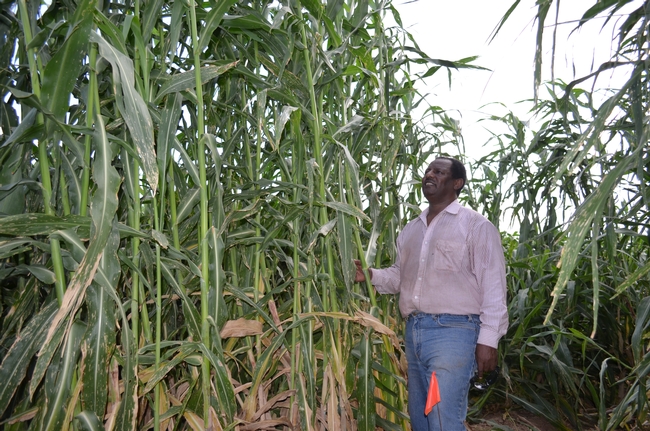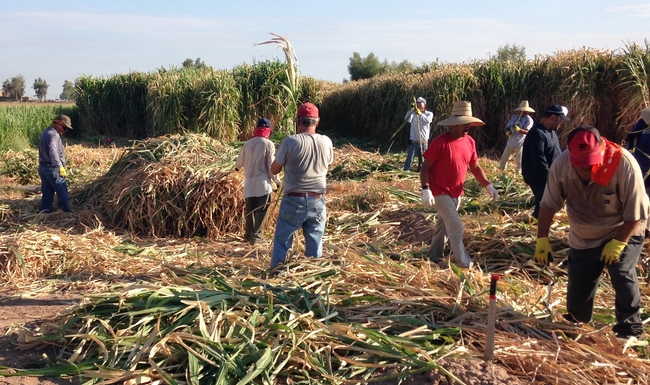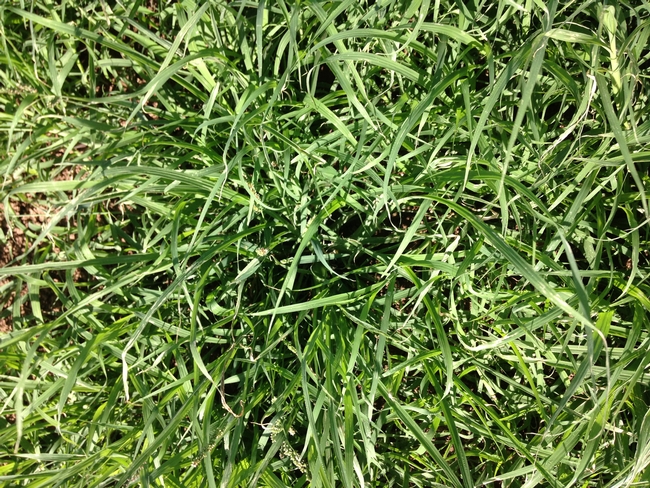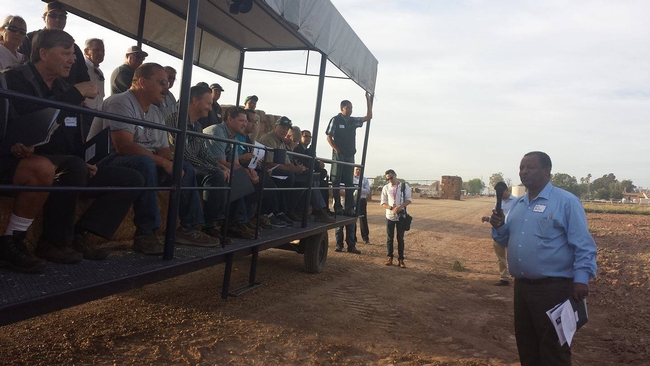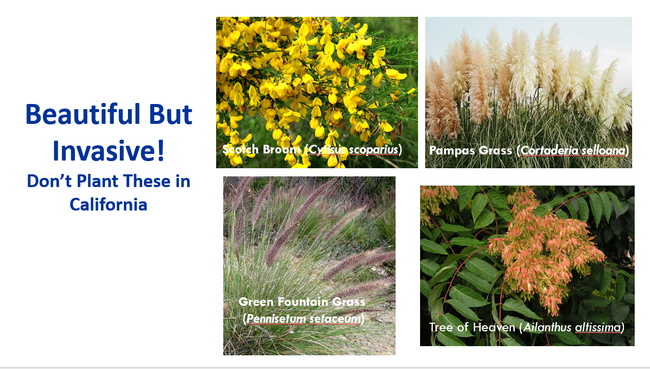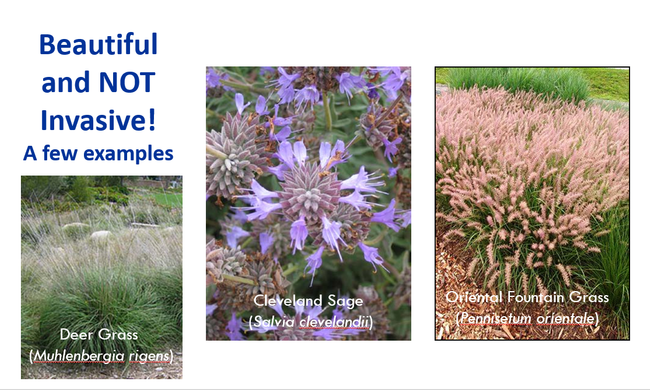
Posts Tagged: grass
Invasive Pest Spotlight: Pampasgrass & Jubatagrass
Invasive Pest Spotlight: Pampasgrass & Jubatagrass The invasive pest spotlight focuses on...
Invasive Ornamentals for Sale
I read an interesting paper* recently about the sale and spread of invasive ornamental plants in...
Former goat herder’s crop research promotes prosperity for Imperial Valley farmers
Oli Bachie, “person of the globe,” researches new desert crops to spur economic growth
While herding goats along dusty roads as a boy growing up in Oromia, Ethiopia, Oli Bachie began striving to improve his economic position in life. His path to a better life passed through the Philippines and Canada before reaching the United States. Now, carrying the mantle of Ph.D., the UC Cooperative Extension farm advisor is doing research to help California farmers take advantage of new opportunities for economic growth.
More than 400 different crops and animals are commercially produced in California. The wide array of agricultural products keep California farmers competitive in the global market. UC Cooperative Extension research into new crops provides growers with information that can lower the risk of trying something new.
Rhodes grass, giant king grass, quinoa and teff are among the crops Bachie has been studying since he joined UC Agriculture and Natural Resources in 2012.
“Giant king grass and Rhodes grass were brought to my attention by companies who wanted me to test their adaptability, biomass yield and nutrition as livestock feed,” Bachie said. “My findings proved that they indeed adapt and produce high biomass and were nutritionally competent or better than many of the low desert grown grass forage crops.”
Two companies provided Bachie with funding to conduct the research. “We do research for industries, companies and growers as long as they provide funding and if we believe that the outcome of the research benefits our clientele and the local economy,” he explained.
Viaspace, a company that grows giant king grass in 11 locations in eight countries on four continents, has relied on Bachie's research for establishing its plantings in the Imperial Valley.
“Oli's research helped us establish basic growing procedures and parameters for Imperial County. It provided the critical information that gave us the confidence to start a larger commercial effort in the desert,” said Haris Basit, vice chairman of Viaspace.
To share information with Imperial Valley growers, Bachie has presented his research results on Rhodes grass varieties at field days and workshops and published in the UCCE Imperial AgBrief newsletter and in the proceedings of the 2019 Western Alfalfa and Forage Crops Symposium. During the COVID-19 pandemic, he has been giving talks via Zoom on Rhodes grass as a new emerging crop, including a zoom workshop organized by the University of Arizona.
“Rhodes grass productivity is well-recognized and is adapted for production not only in the Imperial Valley, but also as far as San Joaquin County and in the state of Arizona,” he said. “A grower in Imperial has started to export Rhodes grass hay to the Middle East. More and more growers within the Imperial Valley and beyond are interested in growing Rhodes grass. I get lots of calls to answer Rhodes grass-related questions. There is now a Rhodes grass seed distributing company in Imperial Valley.”
Giant king grass – a hybrid of elephantgrass and Napier grass, which both grow well as wild plants in Ethiopia – and Rhodes grass are widely grown in Ethiopia. But Bachie didn't study these grasses until he joined UC Cooperative Extension.
Bachie grew up farming with his parents in the rural western part of Oromia, where most coffee and food crops are produced in Ethiopia. “By the way, the name ‘coffee' is derived from a place in Oromia called Kaffaa,” he noted.
“After school in winter, when most farming takes place, I engaged myself in farming,” Bachie said. That afterschool activity piqued his interest in farming and fueled his pursuit of a bachelor's degree in plant sciences from Haromaya University in Ethiopia.
“At that time, when I joined the university, there was only one university in the country,” he said. “I was lucky enough to be one of the few to get university admissions among thousands of high school students.”
In Ethiopia, he worked on a program sponsored by the Ministry of Agriculture and United Nations Food and Agriculture Organization for six years, mostly as a crop protection expert. He studied insects, weeds, pathogens and other crop pests on field crops, vegetables and horticultural crops.
“The experiences I gathered from Ethiopia help me provide services in Imperial County in multidisciplinary pest management – insects, pathogens, weeds and nematodes – at times when we did not have any pest management advisor in Imperial County,” he said. “It has also given me the opportunity to deal with clientele with easy transfer of scientific knowledge.”
Bachie was selected as an FAO fellow to pursue a master's degree in agronomy at the University of the Philippines.
“My area of particular concern then was to look at allelopathy (a chemical inhibition of plant extracts or exudates) as a potential inhibition of weed growth,” Bachie said. His plans to develop a biological weed management approach were disrupted when he graduated with a master's degree and he refused to return to his dictator-led home country.
“Ethiopia was then and is still ruled under a brutal government where educated personnel have little value,” he explained. After graduation, he sought settlement in another country. “That supportive state, which I thank dearly, was Canada.”
After earning a master's degree in forestry from the University of Toronto, Bachie accepted a job at a university teaching network administration and came to the U.S., where he earned a Ph.D. in biological sciences at UC Riverside, “Americanizing not only myself, but also my credential and now I serve UC with full interest and strength,” said Bachie, who holds dual U.S. and Canadian citizenship.
In the spring of 2019, Bachie started comparing grass forage crops (bermudagrass, kleingrass, Rhodes grass and teff) with moringa for livestock feed under low desert conditions. Growers will be able to use the research results to decide which crops will be most profitable for their own operations.
Last summer, Bachie completed a variety trial of quinoa, a grain grown primarily for its edible seeds. He tested the adaptability and grain yield of 35 varieties of quinoa in the heat and biotic stress of the Imperial Valley.
“Of the tested varieties, many tolerated the high heat of the desert and gave promising yields,” said Bachie, who showed the varieties to farmers at an agronomy and irrigation crops field day. “The high grain prices of quinoa in the U.S. and the proof of adaptability and yielding capacity under the low desert condition is expected to attract some growers to grow some quinoa varieties in the Imperial Valley.”
Bachie recently completed a survey of weeds in the county and is planning to publish a handbook titled “Weeds of Imperial County and Management Approaches.”
“While my journey is a huge zigzag and I came up through difficulties, I am very glad that I was able to travel and survive and made myself from a goat herder to an American Ph.D.,” said Bachie, who has also taught biology and environmental science courses part time at Victor Valley and Imperial Valley community colleges, respectively.
“My travel all over the world has enhanced my concepts of human diversity and the affinity to associate and work with people of various backgrounds. To be sure, I call myself a person of the globe.”
Invasive Plants: Don't Encourage 'Bad Neighbors'
What do ice cream, potato chips, Scotch and Spanish Broom, and Tree of Heaven have in common? While they're all tempting to indulge in, less is more. In fact, plants such as Scotch, Spanish Broom, Tree of Heaven, Pampas Grass, Green Fountain Grass, and dozens of plants are all considered invasive plants in California. Simply put, they should not be planted. There are some great alternative plants that are better choices listed at the end of this blog.
Truth be told, I admit to falling madly in love with the Spanish Broom (Spartium junceum) shrubs adorning Highway 18 on my drive from San Bernardino to Lake Arrowhead in early spring 1984 right after my job interview for my current position. Being a “wet behind the ears” recently hatched graduate student from the Midwest I was truly in awe of their lovely yellow blooms and vowed to plant one if I got the chance to move to California. Fortunately, I found out very soon that, while the plantings were made on purpose, they were a mistake and needed to be removed due to their invasive nature.
While they were ‘recruited' from Europe and had what seemed like a perfect resumé (fast growth, lovely yellow flowers, adaptability to poor infertile soil and disease and insect-resistance), they didn't play well with others, a fatal flaw. In California, they were aggressive and crowded out native plantings. Fires only exacerbated the situation. After the 2003 burns, the Spanish Broom populations exploded, obliterating any remaining natives and taking an even larger area hostage. In summer 2010, the San Bernardino National Forest removed the plants in a costly but necessary $500,000 project under a partnership with the American Recovery and Reinvestment Act. Constant monitoring continues in the San Bernardino Mountains and other areas of the state to prevent its reestablishment which is challenging due to its ability to quickly resprout, seed longevity, and effective dispersal. It has definitely earned its ‘noxious weed' label!
This is just one example of the problems posed by invasive plants. In effect, they grow too well! They outcompete desirable plants in our gardens, lawns, and other urban and natural areas for water, nutrients, and space. They also shade sun-requiring plants. Threatened and endangered plant species and other California native plants are particularly vulnerable to their encroachment. (In most cases, invasive plants are non-native species.) Interestingly, our beloved state flower, the California poppy, is an invasive plant in New Zealand, Hawaii and other locations outside of California.
As urban gardeners, we can all greatly reduce the impact of the encroachment of invasive plants in our urban environments. Please don't plant invasive sane remove plantings on your property to stop their spread. Below are some great resources to learn more about invasive plants and find viable replacements:
California Invasive Plant Council: https://www.cal-ipc.org/
Don't Plant a Pest: https://www.cal-ipc.org/solutions/prevention/landscaping/dpp/
Invasive Plants of Southern California:https://www.cal-ipc.org/solutions/prevention/landscaping/dpp/?region=socal
PlantRight: https://plantright.org/about-invasive-plants/plant
Invasive grasses exacerbate wildfire at regional scales: we need regional efforts to manage them
New research published in PNAS (Fusco et al 2019) highlights the role of invasive grasses in...

